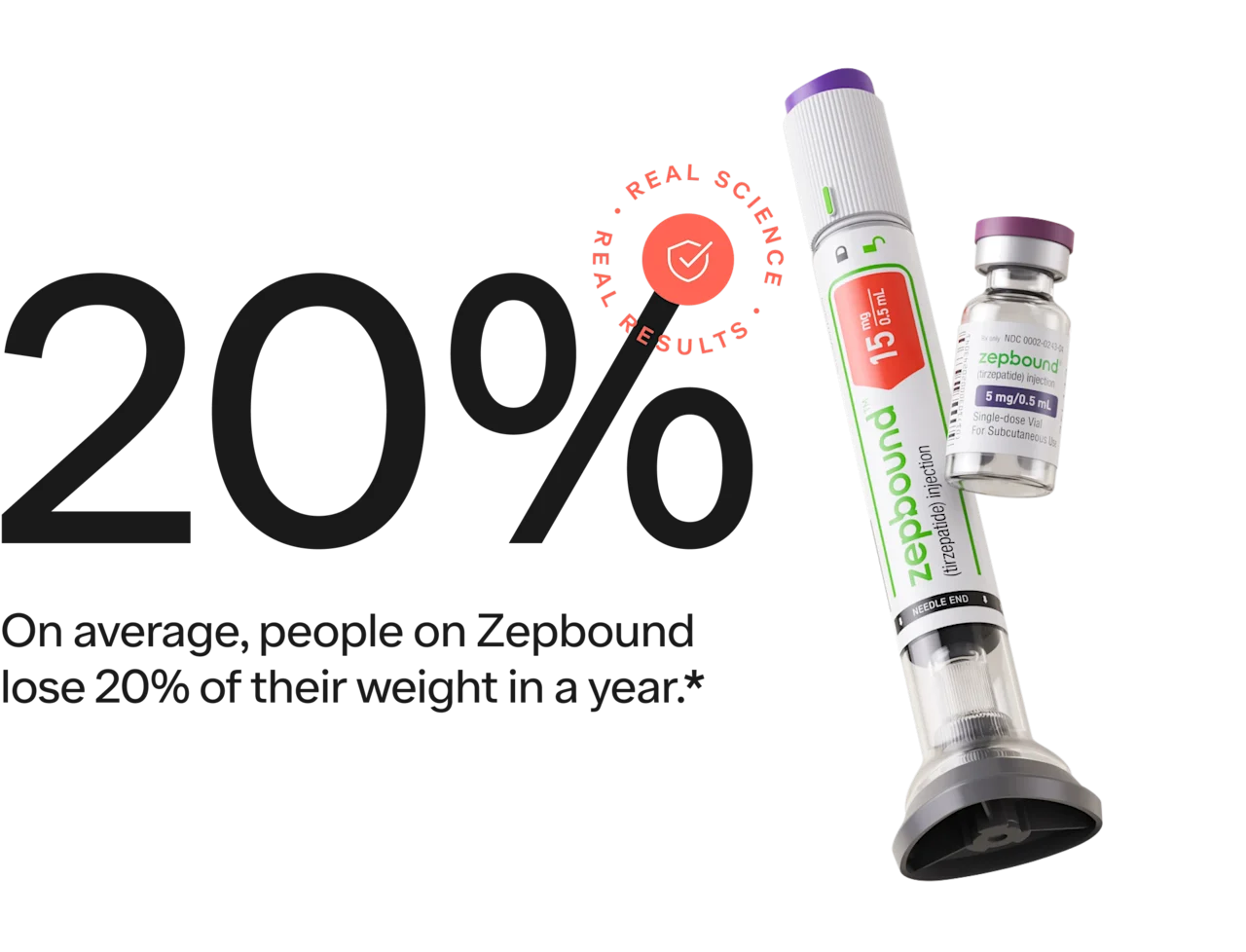Important safety information
What you should know before taking Zepbound.
The fastest-working weight loss medication
Together with LillyDirect, Ro now offers authentic Zepbound (tirzepatide) in a vial. Shipped directly to you, it’s the most convenient way to start your weight loss journey.
A new way to access FDA-approved GLP-1s. See safety info below
The fastest way to lose weight, at half the list price*
Targets two hormone receptors to curb hunger
At Ro, you’ve got options – access Zepbound in a single-dose vial or prefilled pen.
Zepbound uses the same active ingredient (tirzepatide) as Mounjaro®. It’s a dual-action GLP-1/GIP-receptor agonist that is approved by the FDA for people with obesity, or overweight plus a weight-related condition, along with diet and exercise changes.
Zepbound and Wegovy are approved by the FDA for weight loss, while Ozempic is approved for the treatment of type 2 diabetes, but can be prescribed off-label for weight loss, if appropriate.
The main difference between these medications is the active ingredient. Ozempic and Wegovy use semaglutide, while Zepbound uses tirzepatide. Tirzepatide is a dual-action GLP-1 and GIP, meaning it works by activating two receptors to curb nausea and regulate your metabolism, helping you feel full faster and longer. In comparison, semaglutide only activates the GLP-1 receptor.
What’s the difference between Zepbound pens and vials?
Zepbound pens and vials are the exact same FDA-approved medication, but are available in different dosage forms and strengths. This means that when the medication is used in the same dose – whether taken via a vial or pen – it has the same efficacy and side effects. On average, people on Zepbound lose 20% of their weight in a year.*
Key differences:
Zepbound vials are administered with a syringe, while Zepound pens are prefilled.
Zepbound vials are available in 2.5 mg, 5 mg, 7.5 mg, and 10 mg doses. Zepbound pens include those doses plus 12.5 mg and 15 mg.
Zepbound vials can be shipped conveniently and directly to you from the LillyDirect partner pharmacy, while Zepbound pens can only be fulfilled through your preferred pharmacy.
Zepbound vials are only available as a cash pay offering, and are not eligible for insurance coverage. Zepbound pens are available as a cash pay offering or through insurance coverage.
*Price compared to the list price of Zepbound autoinjector pen, without applying insurance or savings cards. Zepbound vials are a cash-pay offering only. Full weight loss results are seen at about 1 year, when combined with diet and exercise.
Safety info: GLP-1 medications are used to treat obesity or overweight (with weight-related problems), along with diet and exercise. They may have serious side effects, including possible thyroid tumors. Do not use if you or your family have a history of a type of thyroid cancer called MTC or MEN 2. See more serious warnings & safety info.
Select your current weight
252lbs
Weight you could lose (lbs):
50lbs
*Average weight loss in 1 year is 20% (compared to 3.1% with diet and exercise alone). Based on a 72-week clinical trial studying the highest doses of Zepbound in non-diabetic patients with obesity, or with overweight plus a weight-related condition, when paired with healthy lifestyle changes.
Whether you want to check your insurance coverage or prefer to pay cash, we got you. Once you’re a member, we take care of any paperwork and insurance back-and-forth so you don’t have to lift a finger.
Share your health history and weight loss goals with us online to get started. A Ro-affiliated provider will review your answers and get back to you within a few days. Depending on your health review, a provider may order a metabolic lab test before moving forward with treatment.
After reviewing your results, your provider will determine if you’re eligible for medication. If you are, they’ll tailor a program with prescription treatment best suited to your unique biology.
If you’d like to use insurance, a dedicated team will connect with your insurance company to determine your coverage. If you’d prefer to pay cash or if coverage is denied, we’ll help you understand your options across our full GLP-1 suite. Zepbound vials cannot be purchased with insurance, and are cash pay only.
If you’re paying cash for your medication, it will typically be shipped to you in 1-4 days. If using insurance, you’ll get your prescription from your preferred pharmacy. Medication costs are not included in Ro Body membership pricing.
You’ll have everything you need, including on-demand provider messaging, personalized medication adjustments, and expert guidance on what to expect on your journey – all as part of your membership.
“With Ro, you actually get to talk to people. It just makes you feel supported and like you can do it."
Gray Ro member and paid partner using Zepbound pen
“I can't even tell you the mindset and clarity this has given me. Yes, the weight came off quick, but there is so much more to it that I didn't even expect.”
Roman Ro member and paid partner using Zepbound
Meet our experts
Ro offers access to weight loss medications and care customized to your needs and goals.
Ro members taking branded GLP-1 medications were paid for their testimonials.
Yes! If you're interested in starting treatment with Zepbound—whether single-dose pens or vials–the first step is completing an online visit so that a medical provider can determine if treatment is right for you. If you’re prescribed Zepbound single-dose vials, they will be shipped directly to your door via the LillyDirect partner pharmacy.
What’s the difference between Zepbound pens and vials?
Zepbound pens and vials are the exact same FDA-approved medication, but are available in different dosage forms and strengths. This means that when the medication is used in the same dose – whether taken via a vial or pen – it has the same efficacy and side effects. On average, people on Zepbound lose 20% of their weight in a year.*
Key differences:
Zepbound vials are administered with a syringe, while Zepound pens are prefilled.
Zepbound vials are available in 2.5 mg, 5 mg, 7.5 mg, and 10 mg doses. Zepbound pens include those doses plus 12.5 mg and 15 mg.
Zepbound vials can be shipped conveniently and directly to you from the LillyDirect partner pharmacy, while Zepbound pens can only be fulfilled through your preferred pharmacy.
Zepbound vials are only available as a cash pay offering, and are not eligible for insurance coverage. Zepbound pens are available as a cash pay offering or through insurance coverage.
Like other GLP-1 medications, Zepbound comes with the risk of potential side effects. Most people experience these side effects when their dose is increased, and they tend to improve once a steady dose is reached. Some of the most common side effects include:
Nausea
Diarrhea
Vomiting
Constipation
Stomach pains
Upset stomach
Indigestion
Injection-site reactions
Fatigue
Belching and gas
Hair loss
Heartburn
Additionally, if you take oral birth control pills, talk to your healthcare provider before you use Zepbound. Birth control pills may not work as well while using Zepbound. Your healthcare provider may recommend another type of birth control for 4 weeks after you start Zepbound and for 4 weeks after each increase in your dose of Zepbound.
More severe side effects are rarer but possible. Serious side effects include:
Thyroid cancer: Zepbound may cause tumors in the thyroid, including thyroid cancer. Watch for possible symptoms, such as a lump or swelling in the neck, hoarseness, trouble swallowing, or shortness of breath. If you have any of these symptoms, tell your healthcare provider. Do not use Zepbound if you or any of your family have ever had a type of thyroid cancer called medullary thyroid carcinoma (MTC) or if you have Multiple Endocrine Neoplasia syndrome type 2 (MEN 2).
Severe stomach problems
Pancreatitis
Gallbladder disease
Rapid heartbeat
Severe allergy (hypersensitivity)
Low blood sugar
Changes in vision in patients with type 2 diabetes
Kidney disease
Suicidal thoughts or behaviors
Pulmonary aspiration during general anesthesia or deep sedation: . In rare instances, some patients undergoing anesthesia during surgical procedures have had stomach contents enter their lungs, which can cause pneumonia and other problems.
You can report quality complaints and side effects to The Lilly Answers Center (TLAC) at +1(800) 545-5979 to notify Lilly, the manufacturer of your medication. They use side effect information to monitor and sometimes report on drug safety.
These are not all of the possible side effects of Zepbound. For more complete information about Zepbound, including Boxed warning, see full Important Safety Information.
Both Zepbound pens and vials should be stored in the refrigerator at 36-46º F, but they may be kept between 46-86º F for up to 21 days, if needed. Store unopened pens and vials in their original cartons to protect them from light.
If you store Zepbound pens at room temperature, do not return them to the refrigerator. Do not freeze the pens. The pen contains glass parts, so if you drop the pen on a hard surface, do not use the pen for your injection.
If you store Zepbound vials at room temperature, throw away any unused portion after 21 days. Do not freeze the medication, and do not use it if it has been frozen. Be sure to throw away any opened vial after using it, even if there is medication left in the vial.
This depends whether you’re prescribed Zepbound single-dose pens or vials.
For Zepbound pens, insurance coverage and copays will vary depending on your plan. Our insurance concierge will work with your provider to determine your coverage for GLP-1 medication and, if necessary, submit a prior authorization request for you. If you’re paying cash, Zepbound pens cost about $1,050/mo. If you have commercial insurance, you may be eligible for a discount through the manufacturer. Learn more about the Zepbound savings card here.
The savings card program doesn’t apply to Zepbound single-dose vials, which are available as a cash pay-only offering:
$349/mo for 2.5 mg dose
$499/mo for 5 mg dose
$499/mo for 7.5 mg and 10 mg doses (with manufacturer offer)
More on the manufacturer offer: LillyDirect is offering the 7.5 mg and 10 mg doses of Zepbound vials at a discounted $499 price—for first fills and refills.
To keep this discounted price for 7.5 and 10 mg refills: You must complete your next refill check-in within 45 days of your last delivery.
What happens if you miss the 45-day window? You’ll be charged the full price of $599 for a 7.5 mg refill or $699 for a 10 mg refill.
We'll send you reminders to complete your refill check-in as the 45-day deadline gets closer.
These medication costs are separate from your Ro Body membership ($45 first month, $145/mo thereafter), which includes our insurance concierge, provider visits, ongoing coaching, and anytime messaging. Learn more about pricing here.
From the experts at ro









